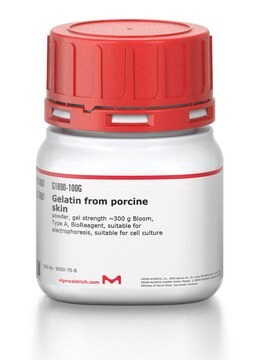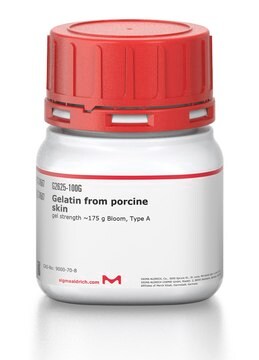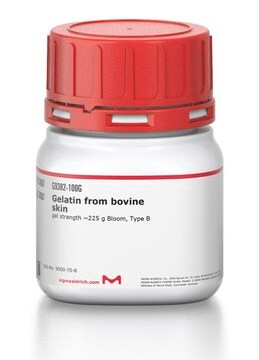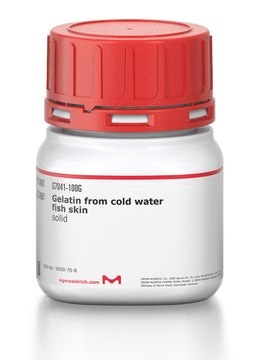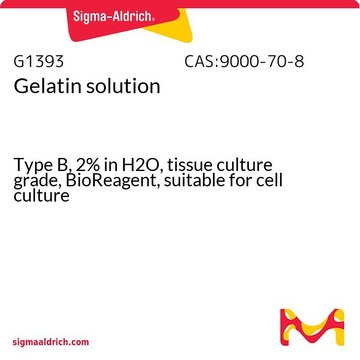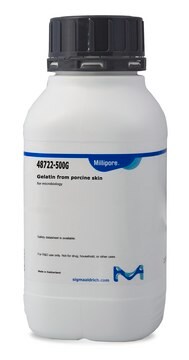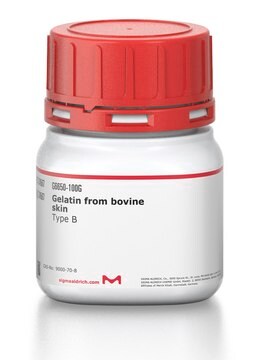G6144
Gelatin from porcine skin
gel strength 80-120 g Bloom, Type A
Synonym(s):
Gelatin powder, Teleostean gelatine
Sign Into View Organizational & Contract Pricing
All Photos(3)
About This Item
Recommended Products
Looking for similar products? Visit Product Comparison Guide
Application
This product is recommended for use as a cell culture substratum at 1-5 μg/cm2 or 0.5-50 μg/mL. The optimal concentration does depend on cell type as well as the application and research objectives.
Gelatin has been used in many applications. It has use in coating cell culture to improve attachment of cells, being added to PCR to stabilize Taq DNA, as a blocking reagent in Western blotting, ELISA, and immunochemistry, and as a component of media for species differentiation in bacteriology. As a biocompatible polymer, it has used as a delivery vehicle for release of active biomolecules and in generation of scaffolds for tissue engineering applications. In the pharmaceutical industry, geltan can be used as a suspending and encapsulating agent, among other applications.
Gelatin has been used in many applications. It has use in coating cell culture to improve attachment of cells, being added to PCR to stabilize Taq DNA, as a blocking reagent in Western blotting, ELISA, and immunochemistry, and as a component of media for species differentiation in bacteriology. As a biocompatible polymer, it has used as a delivery vehicle for release of active biomolecules and in generation of scaffolds for tissue engineering applications. In the pharmaceutical industry, geltan can be used as a suspending and encapsulating agent, among other applications.
Components
Gelatin is a heterogeneous mixture of water-soluble proteins of high average molecular masses, present in collagen. Proteins are extracted by boiling the relevant skin, tendons, ligaments, bones, etc. in water. Type A gelatin is derived from acid-cured tissue. Type B is derived from lime-cured tissue.
Caution
Dry gelatin, when stored in airtight containers at room temperature, will remain unchanged for many years. When heated at 100°C in the presence of air, it swells becomes soft and disintegrates to a carbonaceous mass with evolution of pyridine bases and ammonia.
Preparation Note
This product is derived from porcine skin. Gelatin is soluble in hot than in cold water. It is practically insoluble in most organic solvents such as alcohol, chloroform, carbon disulfide, carbon tetrachloride, ether, benzene, acetone, and oils. The Bloom number, determined by the Bloom gelometer, is an indication of the strength of a gel formed from a solution of the known concentration. The Bloom number is proportional to the average molecular mass. Bloom numbers of porcine skin Gelatin vary from 90 to 300 g. This product has a gel strength of 80-120.
Storage Class Code
11 - Combustible Solids
WGK
nwg
Flash Point(F)
Not applicable
Flash Point(C)
Not applicable
Personal Protective Equipment
dust mask type N95 (US), Eyeshields, Gloves
Certificates of Analysis (COA)
Search for Certificates of Analysis (COA) by entering the products Lot/Batch Number. Lot and Batch Numbers can be found on a product’s label following the words ‘Lot’ or ‘Batch’.
Already Own This Product?
Find documentation for the products that you have recently purchased in the Document Library.
Customers Also Viewed
Anke M Smits et al.
Nature protocols, 4(2), 232-243 (2009-02-07)
To date, there is no suitable in vitro model to study human adult cardiac cell biology. Although embryonic stem cells are able to differentiate into cardiomyocytes in vitro, the efficiency of this process is very low. Other methods to differentiate
Rui Han et al.
Nanoscale, 14(33), 12060-12068 (2022-08-11)
Bacterial mechanical properties (cell wall stiffness and turgor) are important factors for bacterial survival in harsh environments. For an individual bacterial cell, it is challenging to determine the cell wall stiffness and turgor simultaneously. In this study, we adopted a
Matthew T J Lowe et al.
The Journal of comparative neurology, 523(5), 699-725 (2014-08-28)
Creatine is a molecule that supports energy metabolism in cells. It is carried across the plasma membrane by the creatine transporter. There has been recent interest in creatine for its neuroprotective effects in neurodegenerative diseases and its potential as a
Romain Vian et al.
Food chemistry, 360, 130003-130003 (2021-05-17)
TiO2 nanoparticles known as E171 are one controversial food additive due to its potential toxicity. In this work, the main hypothesis is that the proteins adsorbed on the TiO2 nanoparticles prevent their aggregation and favor the cell penetration. To do
Robin Caire et al.
Journal of bone and mineral research : the official journal of the American Society for Bone and Mineral Research, 34(8), 1487-1501 (2019-03-29)
Intermittent parathyroid hormone (iPTH) is anti-osteoporotic and affects bone vessels. Transitional capillaries close to the bone surface, which express both endomucin (Edm) and CD31, bear leptin receptor-expressing (LepR) perivascular cells that may differentiate into osteoblasts. Increased numbers of type H
Articles
Discussion of synthetic modifications to gelatin, improving the three-dimensional (3D) print resolution, and resulting material properties.
Our team of scientists has experience in all areas of research including Life Science, Material Science, Chemical Synthesis, Chromatography, Analytical and many others.
Contact Technical Service
